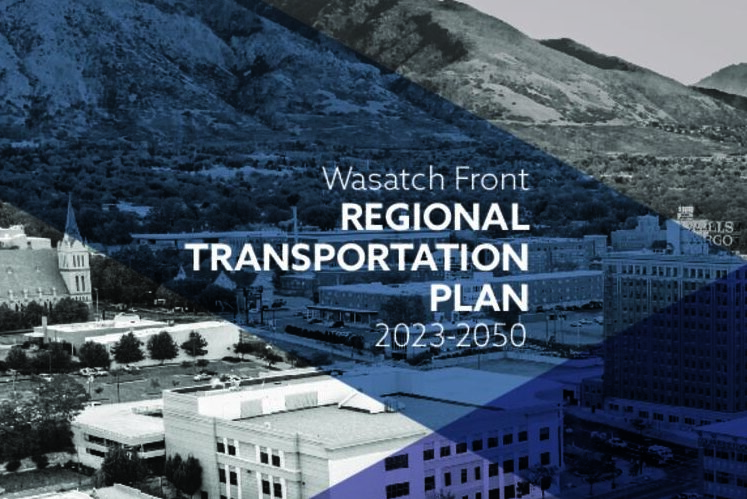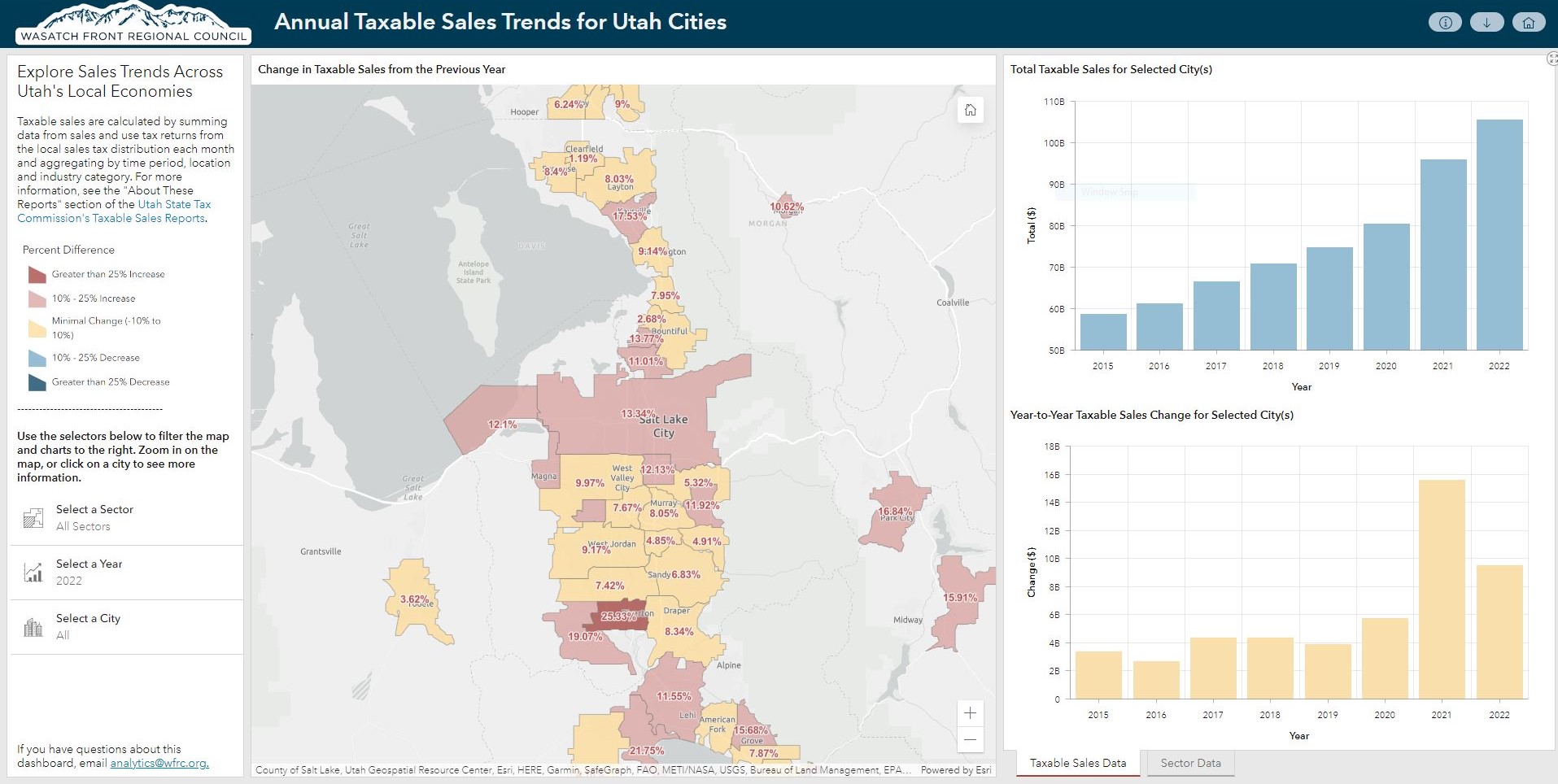Funds planned for 15 priority projects, including enhancements for pedestrians and…

WFRC Unanimously Votes to Adopt Regional Transportation Plan to Enhance Mobility and Address Needs of a Growing Region
Plan includes over 1,000 Bike, Pedestrian, Transit, and Roadway projects through 2050
SALT LAKE CITY – The Wasatch Front Regional Council (WFRC) today unanimously voted to adopt the Wasatch Front 2023-2050 Regional Transportation Plan (2023-2050 RTP) – the official place where tomorrow’s new roads, transit lines and trails start. The 2023-2050 RTP will strengthen our transportation network, providing more choices to get around while reducing traffic congestion along the Wasatch Front. It is part of the Wasatch Choice Vision, a broad strategy to maintain our high quality of life by coordinating plans for new homes and jobs with transportation. The 2023-2050 RTP includes a wide variety of projects to accommodate a growing population, such as expanding public transit options, improving bike and pedestrian infrastructure, and building upon our roadway infrastructure.
WFRC’s 2023-2050 Regional Transportation Plan is a culmination of four years of collaboration between local leaders, transportation agencies, community organizations, local stakeholders, and residents. Specifically, over the next three decades the 2023-2050 RTP identifies nearly $26 billion of priority roadway, transit, and bike and pedestrian projects – over 1,000 projects across the region. That translates into a more balanced, multimodal transportation system that provides Utahns with more choices to reach their destination. The 2023-2050 RTP can be viewed online at bit.ly/2023rtp.
“The Wasatch Front Region, and Utah as a whole, continues to experience high population growth. There are more of us with more places to go,” said South Jordan Mayor Dawn Ramsey, Chair of the Wasatch Front Regional Council. “The 2023-2050 Regional Transportation Plan helps our local communities and transportation partners stay ahead of this growth, working together to plan for the next several decades and build a network of paths, roads, and transit that will benefit all Utahns.”
“The incredible level of collaboration that exists in Utah is often referred to as our ‘secret sauce,’ ” said Davis County Commissioner Bob Stevenson, Vice-Chair of the Wasatch Front Regional Council. “WFRC coordinated over the past four years to create a transportation plan that serves our entire region, now and in the future. I commend everyone involved for their work on the 2023-2050 Regional Transportation Plan.”
The 2023-2050 Regional Transportation Plan is part of the Wasatch Choice Vision, our communities’ shared vision for coordinated transportation investments, development patterns, and economic opportunities. The Vision inter-relates transportation projects with the planned-for location of homes, jobs, and town centers to achieve better outcomes for communities and the Region as a whole – outcomes such as shorter commutes, cleaner air, better access to jobs and schools, and more transportation choices.
The adoption of the 2023-2050 Regional Transportation Plan today reflects the close collaboration between WFRC and a wide variety of public- and private-sector partners. Over the four-year planning process, WFRC hosted more than 30 workshops, engaging hundreds of government, business, and community leaders, and receiving over 3,400 public comments, to craft a transportation plan that meets the mobility needs of our Region.
The 2023-2050 Regional Transportation Plan’s transportation improvements, coupled with the Wasatch Choice Vision centers and future local land use development, are anticipated to have substantial benefits, including:
- 31% more jobs reachable to the average household by driving;
- 71% more jobs reachable to the average household by public transit; and
- 43% more people with nearby access to a bikeway.
A selection of projects in the 2023-2050 Regional Transportation Plan includes the continuation of the West Davis Corridor in Davis and Weber counties, a four-lane divided highway, providing regional and local connectivity and access to jobs and households, and serves as an alternative to I-15. The planned 9000 South Overhead Pedestrian/Bike Crossing in Sandy will better connect residents on both sides of SR-209 (9000 South), increasing access to stores and services. Additionally, public transit riders will experience increased speed and frequency on the UTA’s FrontRunner with planned strategic double tracking of the commuter rail line. These are just three projects among hundreds that can be viewed in the 2023-2050 RTP project map at wfrc.org/rtp-2023-map.
The transportation challenges on SR-210 in and near Little Cottonwood Canyon have received notable attention. The Utah Department of Transportation embarked on an Environmental Impact Statement (EIS) process pursuant to the National Environmental Policy Act (NEPA) to assess transportation alternatives for the Canyon. WFRC, as the Metropolitan Planning Organization (MPO) for the Region, is required to include in the RTP all regionally significant transportation elements currently identified in an EIS or other NEPA environmental process. Thus, included in the 2023-2050 RTP’s Phase 1 (2023-2032) is increased bus service, tolling/congestion-based pricing, and roadway improvements (Phase 1 was funded with $150M from the state during the 2023 legislative session); in Phase 2 (2033-2042) Wasatch Boulevard improvements, avalanche snow sheds; and in Phase 3 (2043-2050) a gondola and base station parking. The timeline identified in the RTP is for planning purposes only as the EIS did not specifically identify an implementation timeline. Learn more about the EIS and its relationship to the RTP at bit.ly/wfrceis. In adopting the RTP, WFRC supported prioritizing of Phase 1 and 2, and implementation and evaluation of Phase 1 and 2, before advancing to Phase 3 of the EIS.
About the Wasatch Front Regional Council (WFRC): The Wasatch Front Regional Council builds consensus and enhances quality of life by developing and implementing visions and plans for a well-functioning multi-modal transportation system, livable communities, strong economy, and healthy environment. Visit wfrc.org to learn more.


